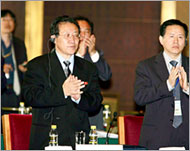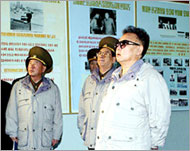US, allies end N Korea reactor project
The US and its partners have dealt the death blow to a multinational project to build two light-water atomic reactors for North Korea.

The reactor-building project was originally devised to entice Pyongyang into dismantling its nuclear weapons programme.
But on Tuesday, the partners in an energy consortium agreed with US policy and terminated the project, which had been kept ticking over in case North Korea showed signs of resuming International Atomic Energy Agency inspections and ending its nuclear weapons programme.
It took almost two years for Washington to wear down the resistance of its partners in the New York-based Korean Peninsula Energy Development Organisation (Kedo), with South Korea finally giving up the partly built light-water reactor last summer.
Japan and the European Union had already sided with the “no carrot” US policy.
No formal statement
On Tuesday, the executive board of Kedo concluded a two-day private meeting, but the US, South Korean, Japanese and EU delegates issued no formal statement.
On his way out of Kedo’s office in New York, however, US ambassador Joseph DiTrani said the Kedo partners had reached consensus on the “termination” of the light-water reactor project, Kedo spokesman Brian Kremer said.
 |
|
Many rounds of six-nation talks |
The decade-old light-water reactor project had been mothballed for the last two years and with a deadline at the end of the month on large contracts underlying the $4.6billion project – notably to the prime South Korean contractor, Korean Electric Power Co – time, money and political will had all evaporated.
Only last week, at a summit of Asian and Pacific leaders in South Korea, US President George Bush said: “We’ll consider the light-water reactor at the appropriate time. The appropriate time is after they have verifiably given up their nuclear weapons, and/or programme.”
The decision comes at a particularly delicate moment in the fitful series of six-nation talks aimed at disarming North Korea. The fifth round of talks among the two Koreas, the US, Russia, China and Japan ended on 11 November without signs of significant progress.
Bilateral accord
A 1994 bilateral nuclear inspection accord and deal to build two monitored light-water reactors cooled tensions and led to the Kedo project.
Charles Kartman, the American who was executive director of Kedo from 2001 until this August, when the Bush administration pushed him into retirement, said North Korea must have anticipated Kedo’s demise.
 |
|
N Korea’s ruler has vowed to |
“There’s no surprise here for North Korea,” he said.
Last May, North Korea’s Foreign Ministry said the country had the ability to harvest still more weapons-grade plutonium and “bolster its nuclear arsenal”.
At the end of the fourth round of six-way talks in September, North Korea pledged in principle to disarm but maintained that it would need light-water reactors to provide electricity beforehand, which would have postponed disarmament for years.
Meanwhile, North Korea says it is escalating its nuclear weapons development programme, the issue that caused both Korean crises in recent years – in 1993-1994 and again in 2002 up to the present.